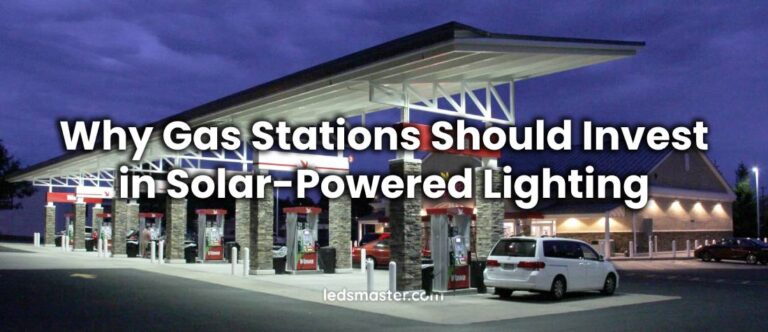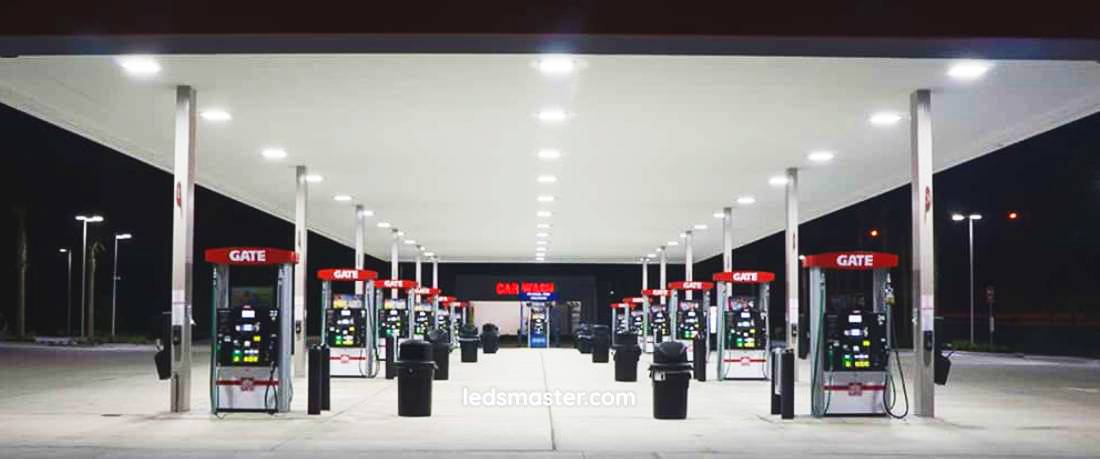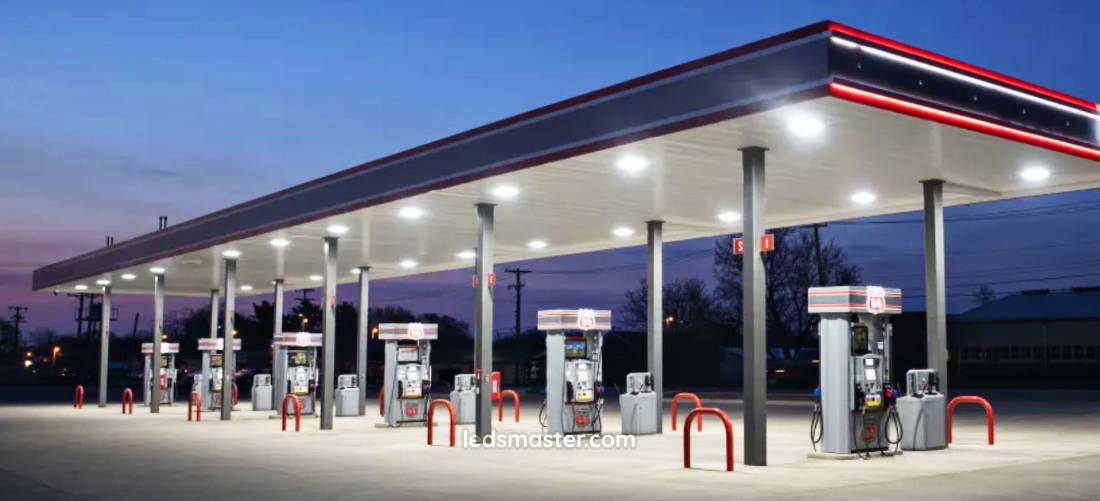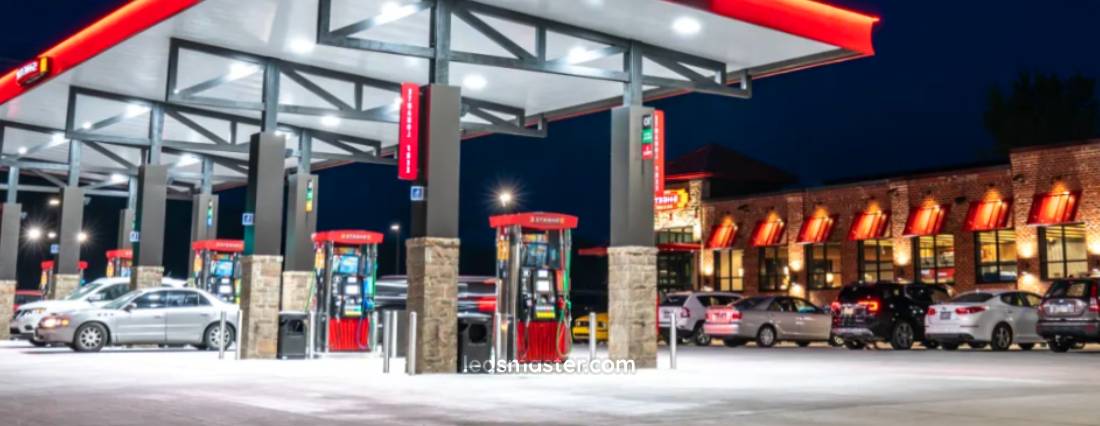
In an age where sustainability and energy efficiency are gaining more attention, solar energy has emerged as one of the most reliable and environmentally friendly solutions. For gas stations, where outdoor lighting is an unavoidable necessity, the use of solar power offers multiple benefits.
Get your complimentary lighting design today
Solar gas station lighting not only reduces operational costs but also contributes to environmental preservation, while ensuring that gas stations are well-lit and safe during the night. This approach provides a practical, cost-effective, and forward-thinking solution to the energy demands of gas station operations.
Table of Contents
ToggleGas stations are a 24-hour operation in many places, making reliable lighting a top priority. Lighting is required for multiple purposes, including illuminating parking areas, pumps, entrances, and signage. Traditionally, gas stations have relied on grid electricity to power their lights, but this method comes with both financial and environmental challenges. By incorporating solar-powered lighting systems, gas stations can offset these issues, making their operations more energy-efficient and reducing long-term energy costs.
The decision to switch to solar gas station lighting brings about multiple advantages. One of the key benefits is the reduction in electricity bills. Solar-powered lighting systems draw energy from the sun, eliminating the need for grid-based power and thus cutting down on ongoing electricity expenses. Additionally, solar lighting systems have low maintenance costs, as they generally have longer lifespans than traditional lighting solutions. These savings in both installation and maintenance costs are significant for gas station owners.
Solar lighting also plays a role in minimizing the environmental impact of gas stations. The energy generated from solar panels is clean, renewable, and reduces reliance on fossil fuels. This not only helps reduce a gas station’s carbon footprint but also contributes to a broader push for green energy solutions across industries.

Solar lighting systems operate using a straightforward mechanism. Solar panels capture sunlight during the day and convert it into electricity, which is then stored in batteries. These batteries power the lights after the sun sets, ensuring that the gas station remains well-lit throughout the night. Some systems also feature motion sensors to conserve energy when the area is not in use. The technology behind solar lights has become increasingly sophisticated, with more durable materials, improved efficiency in energy storage, and even systems that can adapt to weather changes and energy consumption patterns.
A typical solar-powered lighting system consists of several integral components. Understanding the functions of each of these elements helps gas station owners make informed decisions about their lighting setups.
The solar panel is the heart of the solar lighting system. It is responsible for collecting sunlight during the day and converting it into usable electricity. The size and efficiency of the solar panels directly impact the performance of the entire system. Gas stations in areas with ample sunlight might be able to use smaller panels, while stations in regions with less sunlight may need larger, more efficient panels to meet their lighting requirements.
Once solar panels generate electricity, it is stored in batteries for later use. The capacity of these batteries determines how long the lights will function during the night. Advanced batteries, such as lithium-ion batteries, are commonly used in solar lighting systems due to their high energy storage capacity and longevity. The battery must be able to store enough energy during the day to last through the night and into the early morning.
LED lights are the most common type of lighting used in solar systems. They are energy-efficient, durable, and capable of providing bright, consistent illumination with minimal energy usage. LED lights are ideal for gas stations, where large areas need to be illuminated. These lights have a longer lifespan compared to traditional bulbs, reducing the frequency of replacements and maintenance.
The controller regulates the amount of energy flowing from the solar panel to the battery and then from the battery to the lights. It ensures that the system operates optimally by managing energy storage and distribution. Motion sensors are often incorporated into solar gas station lighting systems to detect movement in parking areas or around the pumps. These sensors activate the lights only when necessary, conserving energy and further reducing costs.
There are various types of solar lighting systems suitable for gas stations, each offering distinct features and benefits. Understanding the differences between these systems helps gas station owners select the one that best meets their needs.

Solar pole lights are widely used in gas stations to illuminate parking areas and pump stations. These lights are mounted on tall poles and provide broad coverage, ensuring that large outdoor spaces are well-lit. Solar-powered pole lights are easy to install, as they do not require wiring to the grid. They are also available in different designs and brightness levels, offering flexibility to meet the specific needs of the gas station.
For gas stations with covered areas such as canopy roofs, solar canopy lights are an excellent solution. These lights are integrated directly into the canopy structure, providing uniform illumination across the entire fueling area. Solar canopy lights are often equipped with high-efficiency solar panels and LED lights to maximize energy savings.
Gas stations typically feature large signage that needs to be illuminated at night. Solar signage lighting is a popular choice for this purpose. Solar-powered signs are equipped with small solar panels that provide the necessary energy to light up the station’s logos, pricing displays, and other advertising materials. This type of lighting ensures that the gas station’s branding remains visible at night without drawing from the grid.
One of the primary reasons for the growing adoption of solar lighting in gas stations is its environmental benefit. Traditional lighting systems rely on grid power, which often comes from non-renewable sources such as coal and natural gas. By transitioning to solar-powered systems, gas stations can dramatically reduce their carbon emissions.
Solar lighting systems significantly reduce the carbon footprint of gas stations. The energy produced by solar panels is clean, and since solar panels do not require fossil fuels for their operation, there are no direct emissions associated with their use. Over time, the transition to solar lighting can result in a substantial reduction in greenhouse gas emissions.
The table below illustrates the potential reduction in carbon emissions when switching from traditional lighting systems to solar-powered systems for a typical gas station.
| Lighting Type | Annual Energy Consumption (kWh) | Annual CO2 Emissions (kg) | Solar Lighting CO2 Emissions (kg) | CO2 Reduction (%) |
|---|---|---|---|---|
| Traditional Lighting | 5,000 | 3,500 | 0 | 100% |
| Solar Lighting | 0 | 0 | 0 | 100% |
Another notable advantage of solar gas station lighting is the decreased reliance on the electrical grid. By generating their own power, gas stations are less vulnerable to fluctuations in grid electricity costs or potential outages. This energy independence can contribute to the long-term stability of a gas station’s operations.

While the initial investment in solar lighting systems can be higher than traditional lighting, the long-term savings are significant. Over time, gas stations can recoup their investment through lower energy bills and minimal maintenance costs. Additionally, various incentives and rebates are available for businesses that adopt solar energy, making the transition to solar-powered lighting even more cost-effective.
The payback period refers to the amount of time it takes for the cost savings from reduced electricity bills to equal the initial investment in solar lighting. For most gas stations, the payback period typically ranges from 3 to 5 years. After the payback period, gas stations can enjoy several years of free energy, further enhancing the financial benefits of switching to solar lighting.
The installation process for solar lighting is relatively simple, especially in comparison to traditional lighting systems that require complex wiring and electrical work. Solar lighting systems are often designed to be mounted directly on poles or structures, which makes installation quick and convenient. Furthermore, because solar lights do not rely on the grid, the risk of electrical hazards is minimized.
Solar lighting systems generally require very little maintenance. Solar panels, batteries, and LEDs are durable and designed to last for many years. Routine cleaning of the solar panels is recommended to ensure optimal performance, as dirt and debris can reduce the efficiency of the solar cells. The batteries may also need to be replaced every few years, depending on their type and usage. However, the overall maintenance costs for solar lighting systems are much lower than those for traditional lighting systems, which often require frequent bulb replacements and electrical repairs.
Solar gas station lighting represents a forward-thinking, sustainable solution for modern fueling stations. The shift to solar power offers a range of benefits, from reduced operational costs and energy independence to a smaller environmental footprint. As solar technology advances and becomes more affordable, the adoption of solar-powered lighting systems is likely to continue growing, offering gas stations an effective way to meet their lighting needs while contributing to a greener future.